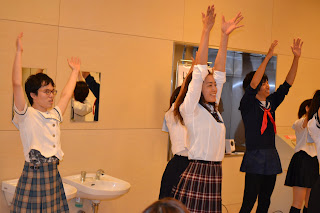I have arrived to the bustling city of Tokyo, where Red Bulls reign, and under-slept people can be seen catching naps just about everywhere.
On first impression, Tokyo was different than I had expected. The buildings are not skyscrapers, the city is more of an L.A.-like urban sprawl than a tightly packed Manhattan, and wi-fi, unfortunately, does not seep out of every building.
I stayed the first few nights in traditional wakan housing, a large room enclosed by shoji screens and floored with bamboo tatami mats. I shared the space with about fifteen other people, each of us sleeping on our own futon mat covered by a simple blanket. This style of sleeping is surprisingly comfortable, especially when the summer weather brings 95+ degree heats and thick humidity.

On first impression, Tokyo was different than I had expected. The buildings are not skyscrapers, the city is more of an L.A.-like urban sprawl than a tightly packed Manhattan, and wi-fi, unfortunately, does not seep out of every building.
I stayed the first few nights in traditional wakan housing, a large room enclosed by shoji screens and floored with bamboo tatami mats. I shared the space with about fifteen other people, each of us sleeping on our own futon mat covered by a simple blanket. This style of sleeping is surprisingly comfortable, especially when the summer weather brings 95+ degree heats and thick humidity.

My orientation program in Japan is run by the Harvard College in Asia Program (HCAP), a partnership that encourages collaboration between Asian universities and Harvard. Students from the University of Tokyo have graciously hosted me and my colleagues for the majority of our stay in Japan. HCAP encourages cultural exchange, so our first evening together, our Japanese friends performed a highly-choreographed, cross dressing-friendly dance routine. We returned the favor by teaching them how to duggie.
After a long day of lectures, several people took me out for my twenty-second birthday to a traditional sake house. I can’t say that I enjoy sake particularly much, but the Japanese among the group were very impressed to learn of the US invented sake bomb. It turns out, most young Japanese enjoy western cocktails, and sake is mostly enjoyed by the elderly.
I woke up at 4:30am today in order to make it to the opening of the Tsukiji fish market, Tokyo’s most famous open-aired market. Vegetarian-friendly food is hard to come by in Japan, and Tsukiji market may be one of the worst places to go for a noodle or tofu meal. I managed to find a place that served vegetable tempura for breakfast (Japanese breakfasts are full dinner-style meals) and was quite happy observing the bustle of the marketplace and nearby Shinto shrines.
Tonight, I am off to experience karaoke in downtown Tokyo and will then hop on an overnight bus to Kyoto. In the next few days, I will explore the city of Kyoto--one of Japan’s cultural gems--stay the night in a Buddhist temple, learn how to meditate from Zen monks, and visit the Hiroshima Peace Memorial.






No comments:
Post a Comment